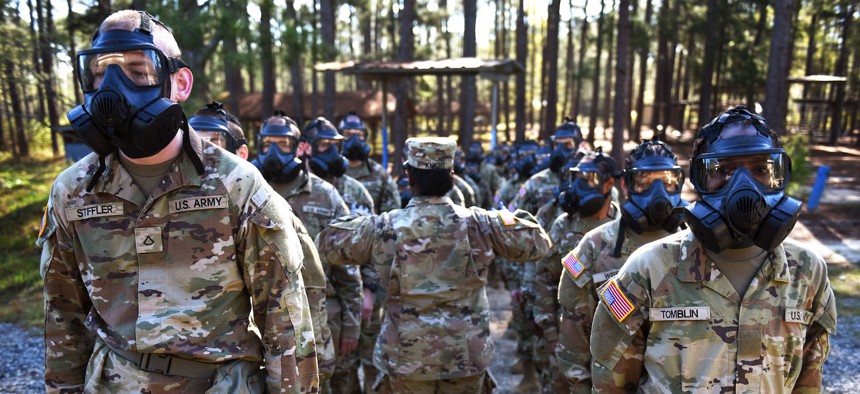
Army infantry recruits with the 2nd Battalion, 58th Infantry Regiment take on the gas chamber on Fort Moore, Georgia, March 30, 2023. U.S. Army / Christopher Hurd
Army aims to cut 32,000 billets over five years, including 3,000 in special operations
Service leaders say they are also planning for other cuts if Congress fails to pass a budget or supplemental funding for aid to Ukraine and Israel.
The Army intends to consolidate its force structure to close gaps left by recruiting shortfalls and to shift manpower from outdated jobs to emerging ones, the service secretary announced Tuesday.
“Because of the recruiting challenges, our end strength has decreased notably and we”—Army Secretary Christine Wormuth and Chief of Staff Gen. Randy George—“did not want to have a lot of hollow structure hanging around,” Wormuth told reporters at a Defense Writers Group event. “We needed to reduce 32,000 spaces to both shrink over structure and make room” for about 7,500 new billets for emerging efforts like directed energy, the Mobile Short Range Air Defense program, and multi-domain task force teams.
Wormuth said the changes will take about five years. Many of the billets will be cut from former focus areas, like counterterrorism and counterinsurgency.
Some 3,000 billets will be cut from Army special operations formations—largely jobs that have been difficult to fill or aren’t as relevant like print media and psychological operations.
“The things that we want to not have in our formation are actually things that we don’t think are going to make us successful on the battlefield going forward,” George said at the same event. “There’s other things that we do think we need to grow and add: counter-UAS, integrated air and missile defense” and shrinking the number of people needed at a command post.
George said the Army is trying “adapt ahead” of emerging threats.
“We are acutely aware of the world and how it’s changing. We have a real sense of urgency to adapt ahead of it…how we operate, how we buy stuff, how we’re training our people,”
The Army is also eyeing cuts where it can if Congress fails to deliver a budget for this year or supplemental funding for Ukraine, Wormuth said.
“We are cash flowing…the training that we’re doing with the Ukrainians to the tune of about $500 million that we’ve spent so far. And we were counting on the supplemental [funding bill] to be able to sort of replenish us for that. If that’s not going to come, that’s a very substantial part” of the operations and maintenance budget of U.S. Army Europe and Africa, she said.
The same goes for U.S. support to Israel for its war on Hamas, including preparatory deployments to the region.
“The price tag for that isn’t as large but again the chief and I do worry,” Wormuth said. “If we don’t get a budget and we don’t get a supplemental, we’re probably going to have to cancel some things.”
That could mean deciding to cut planned military exercises in the coming months.
“Probably by late spring, summer we would have to make some difficult choices about other exercises, for example, that we had planned to participate in,” including several with NATO, she said.
The comments come after the Army canceled its $2 billion manned helicopter development program, the Future Attack Reconnaissance Aircraft, or FARA, and the Shadow and Raven drones.
Wormuth said the FARA decision was not the result of a flawed requirements process, but more of a reflection of how the battlefield has changed.
“We have an overall aviation portfolio that we’ve got to keep healthy. And our ability—within a flat budget—to be able to pursue both FARA and [Future Long-Range Assault Aircraft], which we are continuing to pursue…just something had to give,” she said.
NEXT STORY: Top Pentagon IT official departs deputy CIO role
